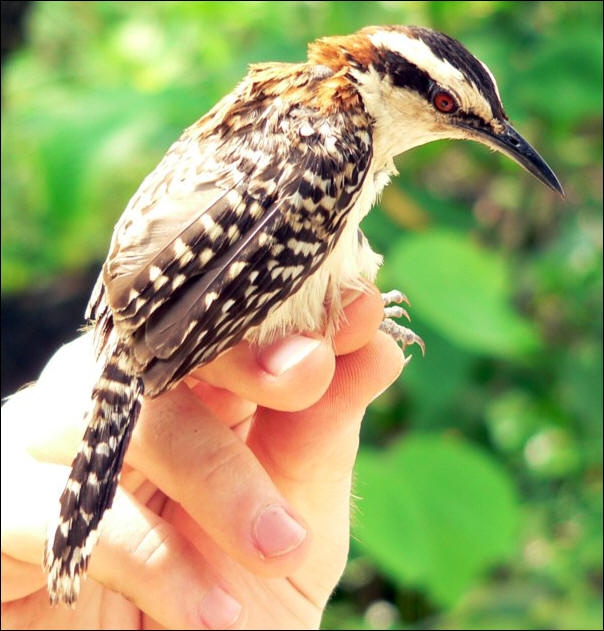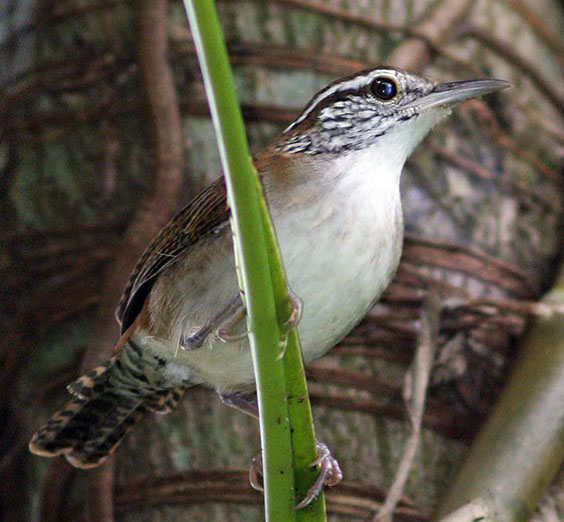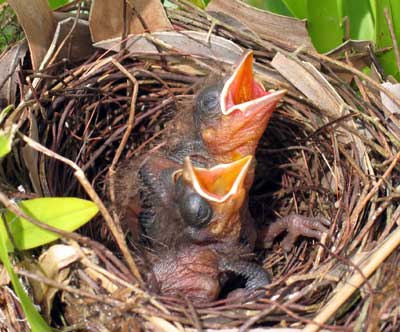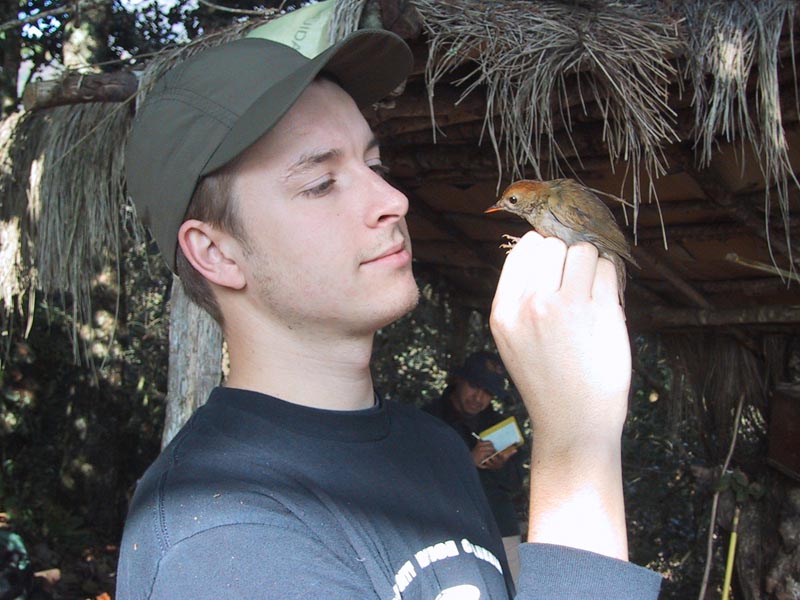David W. Bradley
Research
I have been fortunate enough to have worked on avian ecology research projects in a number of countries, specifically in Latin America (Costa Rica, Peru, Panama, Mexico, and Colombia). I have also assisted on projects in the United States and here in Canada.
Costa Rica
 My current graduate research
interests stem from my
fascination and adoration of birds. From an early age I
marvelled at their diversity of form and behaviour. Although my
interests vary widely in the field of avian biology, currently I
am interested in avian communication. More specifically I would
like to determine the way in which coordinated group displays by
birds living and breeding cooperatively function in maintaining
social bonds and establishing resource ownership. My study
species is a feisty tropical songbird, the Rufous-naped Wren (Campylorhynchus
rufinucha). This bird occurs in the dry forests of
Central America from Mexico in the north to Costa Rica in the
south. They live in extended family groups that live and defend
all purpose, year-round territories. They sing rich and varied
songs of pure whistles interspersed with harsh barks, chatters
and rattles. Songs are sung as solos, duets and choruses and
it is this diversity of song contributors that I am most
interested in.
My current graduate research
interests stem from my
fascination and adoration of birds. From an early age I
marvelled at their diversity of form and behaviour. Although my
interests vary widely in the field of avian biology, currently I
am interested in avian communication. More specifically I would
like to determine the way in which coordinated group displays by
birds living and breeding cooperatively function in maintaining
social bonds and establishing resource ownership. My study
species is a feisty tropical songbird, the Rufous-naped Wren (Campylorhynchus
rufinucha). This bird occurs in the dry forests of
Central America from Mexico in the north to Costa Rica in the
south. They live in extended family groups that live and defend
all purpose, year-round territories. They sing rich and varied
songs of pure whistles interspersed with harsh barks, chatters
and rattles. Songs are sung as solos, duets and choruses and
it is this diversity of song contributors that I am most
interested in.
My study site is in Parque Nacional Santa Rosa in Guanacaste Province of northwest Costa Rica. Here I follow and record the songs of family groups. I will use these data to determine if families use certain distinct songs that encode group membership and identity. This coming field season in Costa Rica I will perform song playback experiments to assess the relative roles of songs performed by single birds, duetting pairs and by larger family groups.
Click here to hear an example of a Rufous-naped Wren song from Costa Rica.
Back to top
I have been fortunate enough to have worked on avian ecology research projects in a number of countries, specifically in Latin America (Costa Rica, Peru, Panama, Mexico, and Colombia). I have also assisted on projects in the United States and here in Canada.
Colombia  Recently
I took part in a investigative research trip to Colombia to work
with local ornithologist Sandra Valderrama. Sandra is a well
known biologist who has studied the critically endangered Niceforo's
Wren. Her goal is to protect this species on the brink of
extinction by understanding is biology, in particular its vocal
behaviour. In this study we were recording the vocalizations
of a very closely related species of bird, the Rufous-and-white
Wren. More specifically we were recording the minlosi
subspecies of this bird which Niceforo's Wren probably recently
speciated from. Recently
I took part in a investigative research trip to Colombia to work
with local ornithologist Sandra Valderrama. Sandra is a well
known biologist who has studied the critically endangered Niceforo's
Wren. Her goal is to protect this species on the brink of
extinction by understanding is biology, in particular its vocal
behaviour. In this study we were recording the vocalizations
of a very closely related species of bird, the Rufous-and-white
Wren. More specifically we were recording the minlosi
subspecies of this bird which Niceforo's Wren probably recently
speciated from.Back to top |
Costa Rica
 My current graduate research
interests stem from my
fascination and adoration of birds. From an early age I
marvelled at their diversity of form and behaviour. Although my
interests vary widely in the field of avian biology, currently I
am interested in avian communication. More specifically I would
like to determine the way in which coordinated group displays by
birds living and breeding cooperatively function in maintaining
social bonds and establishing resource ownership. My study
species is a feisty tropical songbird, the Rufous-naped Wren (Campylorhynchus
rufinucha). This bird occurs in the dry forests of
Central America from Mexico in the north to Costa Rica in the
south. They live in extended family groups that live and defend
all purpose, year-round territories. They sing rich and varied
songs of pure whistles interspersed with harsh barks, chatters
and rattles. Songs are sung as solos, duets and choruses and
it is this diversity of song contributors that I am most
interested in.
My current graduate research
interests stem from my
fascination and adoration of birds. From an early age I
marvelled at their diversity of form and behaviour. Although my
interests vary widely in the field of avian biology, currently I
am interested in avian communication. More specifically I would
like to determine the way in which coordinated group displays by
birds living and breeding cooperatively function in maintaining
social bonds and establishing resource ownership. My study
species is a feisty tropical songbird, the Rufous-naped Wren (Campylorhynchus
rufinucha). This bird occurs in the dry forests of
Central America from Mexico in the north to Costa Rica in the
south. They live in extended family groups that live and defend
all purpose, year-round territories. They sing rich and varied
songs of pure whistles interspersed with harsh barks, chatters
and rattles. Songs are sung as solos, duets and choruses and
it is this diversity of song contributors that I am most
interested in.My study site is in Parque Nacional Santa Rosa in Guanacaste Province of northwest Costa Rica. Here I follow and record the songs of family groups. I will use these data to determine if families use certain distinct songs that encode group membership and identity. This coming field season in Costa Rica I will perform song playback experiments to assess the relative roles of songs performed by single birds, duetting pairs and by larger family groups.
Click here to hear an example of a Rufous-naped Wren song from Costa Rica.
Back to top
Peru  Recently
I took part in a
collaborative research project with
Dan Mennill
(my graduate thesis advisor),
Stephanie Doucet,
Peter Slater of the University of St. Andrews, and other
graduate students from the University of Windsor
on the vocalizations of the
Inca Wren (Thryothorus
eisenmanni). Inca Wrens have a very restricted
distribution, occurring only in montane bamboo scrub in the
immediate vicinity of the stunning ruins of the historic
city of Machu Picchu, Peru. They are a songbird of the genus Thryothorus, some
of the most accomplished singers in the bird world.
Inca Wrens live in small family groups
of 2-6 birds and sing loudly in a highly coordinated vocal
chorus to defend their territories. It was therefore our
research goal to record the songs of this marvellous bird and determine how the individual
birds contribute to the chorus and how this differs from other
closely related species. It has been
shown that the Inca Wren's closest relative, the
Plain-tailed Wren (Thryothorus
euophrys), sings in highly coordinated choruses of up to
7 birds, with males and females each contributing different
alternating parts. Our recordings of the Inca Wrens at
Machu Picchu will be used to write a descriptive scientific
paper 0f their vocalizations and in a comparative paper of
the entire thryothorus genus. Recently
I took part in a
collaborative research project with
Dan Mennill
(my graduate thesis advisor),
Stephanie Doucet,
Peter Slater of the University of St. Andrews, and other
graduate students from the University of Windsor
on the vocalizations of the
Inca Wren (Thryothorus
eisenmanni). Inca Wrens have a very restricted
distribution, occurring only in montane bamboo scrub in the
immediate vicinity of the stunning ruins of the historic
city of Machu Picchu, Peru. They are a songbird of the genus Thryothorus, some
of the most accomplished singers in the bird world.
Inca Wrens live in small family groups
of 2-6 birds and sing loudly in a highly coordinated vocal
chorus to defend their territories. It was therefore our
research goal to record the songs of this marvellous bird and determine how the individual
birds contribute to the chorus and how this differs from other
closely related species. It has been
shown that the Inca Wren's closest relative, the
Plain-tailed Wren (Thryothorus
euophrys), sings in highly coordinated choruses of up to
7 birds, with males and females each contributing different
alternating parts. Our recordings of the Inca Wrens at
Machu Picchu will be used to write a descriptive scientific
paper 0f their vocalizations and in a comparative paper of
the entire thryothorus genus.
Click here to hear an example of an Inca Wren song I recorded at Machu Picchu. Back to top |
Panama In 2005 I worked as a project supervisor on
a comparative
study of avian life histories in Panama. This NSF funded
project is known as the
Life
History-Physiology Nexus, a comprehensive comparison
of the physiology and behaviour of tropical and temperate
organisms. Researchers from the University of Illinois,
Princeton, UC Davis, Ohio State and Oregon State University
collaborate on this study to assess a fundamental prediction
of life history theory: that extended breeding seasons and
low adult mortality select for a slower pace of life in the
tropics, which manifests as lower parental investment in
offspring and higher allocation of resources to adult
maintenance. The study site for this project was in and
around the town of Gamboa, in the former canal zone of
central Panama. I was involved in locating and monitoring
multiple species nest sites to collect baseline breeding
data such as clutch sizes, timing of incubation and breeding
densities. I also set up video cameras on nests to In 2005 I worked as a project supervisor on
a comparative
study of avian life histories in Panama. This NSF funded
project is known as the
Life
History-Physiology Nexus, a comprehensive comparison
of the physiology and behaviour of tropical and temperate
organisms. Researchers from the University of Illinois,
Princeton, UC Davis, Ohio State and Oregon State University
collaborate on this study to assess a fundamental prediction
of life history theory: that extended breeding seasons and
low adult mortality select for a slower pace of life in the
tropics, which manifests as lower parental investment in
offspring and higher allocation of resources to adult
maintenance. The study site for this project was in and
around the town of Gamboa, in the former canal zone of
central Panama. I was involved in locating and monitoring
multiple species nest sites to collect baseline breeding
data such as clutch sizes, timing of incubation and breeding
densities. I also set up video cameras on nests to determine the frequency of incubation and chick feeding
bouts as a measure of parental investment, measured
developing chick morphometrics such as growth rates and
conducted neophobia experiments on nests. We also
maintained an egg incubator in our lab to determine if the
rate of egg development is constrained by the constancy of
temperature and humidity around the egg and provide
base-line hatching periods.
determine the frequency of incubation and chick feeding
bouts as a measure of parental investment, measured
developing chick morphometrics such as growth rates and
conducted neophobia experiments on nests. We also
maintained an egg incubator in our lab to determine if the
rate of egg development is constrained by the constancy of
temperature and humidity around the egg and provide
base-line hatching periods.In 2003 I assisted in the project of a fellow student, Janeene Touchton, on her graduate research project in Panama. We were interested in assessing the effects of competitive release on the foraging dynamics of ant-following antbirds. Specifically we were comparing foraging dominance interactions at ant swarms at 2 different sites, one of which had undergone the local extirpation of a large dominant species. Our study sites were located in the former Canal Zone of central Panama, in an around the large man-made Gatun Lake that forms the majority of the current passage between the Atlantic to Pacific Oceans. Our treatment site was the long-term Smithsonian research station on Barro Colorado Island and the mainland adjacent site in Soberania National Park. For this project I captured our study species, Bicoloured, Spotted and Ocellated Antbirds, and applied unique, coloured leg bands. This allowed me to conduct focal behavioural observations on each species as they foraged on flushed arthropods at army-ant (Eciton burchelli) swarms. I also collected blood samples from all the birds I captured for use in future genetic studies. To some birds I applied small radio transmitters and with the aid of radio telemetry equipment located and tracked active ant colonies. Back to top |
USA
 In the summer of 2004 I worked with Joe Fontaine on his PhD research at Oregon State University. His project was a study on the effects of post-wildfire salvage logging on the unique wildlife of the Siskiyou Mountain in South-west Oregon. The work involved a regular census of the birds, small mammals and vegetation in each treatment area, with varying levels of burn severity and salvage intensity. It was a great way to experience this fascinating landscape and learn some novel field techniques such as mammal trapping using Sherman traps. Back to top |
Mexico I was very fortunate in 2003 to receive funding
through UBC
to assist on a research project in Chiapas, Mexico. I worked
alongside José-Luis Rangel-Salazar who was conducting his PhD
research on the demography and habitat selection of tropical
resident and neotropical migratory birds. More specifically he
wanted to know how closely related birds partition resource use
in the same habitat. The resident Ruddy-capped
Nightingale-Thrush (Catharus
fratzii) and the migratory Swainson's Thrush (Catharus
ustulatus) both live in the cloud-drenched mountain
forests surrounding San Cristobal de las Casas. My role in this
project was in capturing, measuring and applying colour bands to
the legs of these two species. The findings of this work was
recently
published by Jose and other researchers in the journal
Ornitologia Neotropical. I was very fortunate in 2003 to receive funding
through UBC
to assist on a research project in Chiapas, Mexico. I worked
alongside José-Luis Rangel-Salazar who was conducting his PhD
research on the demography and habitat selection of tropical
resident and neotropical migratory birds. More specifically he
wanted to know how closely related birds partition resource use
in the same habitat. The resident Ruddy-capped
Nightingale-Thrush (Catharus
fratzii) and the migratory Swainson's Thrush (Catharus
ustulatus) both live in the cloud-drenched mountain
forests surrounding San Cristobal de las Casas. My role in this
project was in capturing, measuring and applying colour bands to
the legs of these two species. The findings of this work was
recently
published by Jose and other researchers in the journal
Ornitologia Neotropical.Back to top |
Canada My first field work positions were
with Kathy Martin at the University of British Columbia on her
NestWeb project up in the Caribou-Chilcotin region of Central
British Columbia. This study is a long term assessment of
the dynamics of a community of cavity-nesting birds, such as
woodpeckers, chickadees, ducks, swallows and owls. This
taxonomically diverse guild of birds all nest in holes in trees
and it is the use and reuse of these holes that is the central
research goal of this project. In the summers of 2001 and
2002 I assisted on this project in various roles. I was
primarily involved in locating and monitoring nesting activity,
performing population censuses and capturing and banding birds.
In an effort to assess the impact of Mountain Pine Beetle
infestations in the area, I also performed rigorous
vegetation
sampling. This project was a great start for me in
my career where I learned many of the ins and outs of ecological
research. My first field work positions were
with Kathy Martin at the University of British Columbia on her
NestWeb project up in the Caribou-Chilcotin region of Central
British Columbia. This study is a long term assessment of
the dynamics of a community of cavity-nesting birds, such as
woodpeckers, chickadees, ducks, swallows and owls. This
taxonomically diverse guild of birds all nest in holes in trees
and it is the use and reuse of these holes that is the central
research goal of this project. In the summers of 2001 and
2002 I assisted on this project in various roles. I was
primarily involved in locating and monitoring nesting activity,
performing population censuses and capturing and banding birds.
In an effort to assess the impact of Mountain Pine Beetle
infestations in the area, I also performed rigorous
vegetation
sampling. This project was a great start for me in
my career where I learned many of the ins and outs of ecological
research.Back to top |